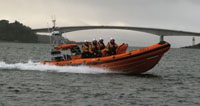|
The station is located on Scotland’s remote, rural west coast in Kyle of Lochalsh, facing the Isle of Skye, some 100km west of Inverness. Surrounded by picturesque sea lochs (sea inlets) and steep, rugged mountains, the village lifeboat station lies in a challenging RF environment. “The RNLI uses a non-secure, VHF analogue radio system to communicate between the lifeboat station and the lifeboat”, explained Martin Benke, Airwave’s UK network services director. “This radio system is perfectly suitable for line-of-sight and point-to-point communications, but its location made for a difficult situation.” So difficult was it that RNLI crews have had to resort to using mobile phones when they experienced gaps in communication. The problem can become even more serious when the lifeboat operates in the area’s sea lochs. “When we go into areas such as Loch Alsh, Loch Long and Loch Duich, the lifeboat loses all forms of communications”, explained Alex Marshall, RNLI operations communications and information manager. “This is particularly treacherous as not only does the lifeboat station lose contact with the lifeboat, but the lifeboat also has no way of communicating with the coastguard.” Secure connectionMr Marshall added: “In other areas where communications have also been poor, we have put in repeaters. However, they cannot always solve the issue due to the surrounding terrain.” At a meeting between the RNLI and Airwave, it was decided to approach the Government to find whether it would allow the RNLI to be connected to the secure Airwave network through its existing VHF system. After working with the National Policing Improvement Agency’s security panel, it was agreed that a back-to-back connection into the Airwave network would be the best option. This involved the installation of an Airwave terminal in the lifeboat station to convert Airwave calls into VHF transmissions, and vice versa. Alex Marshall designed the interface unit, which was manufactured by PMR Products. The equipment was installed at the station and on its Atlantic 85 Class lifeboat. “The crew use the network through the intercom system on the lifeboat”, Mr Marshall said. “The concept of operation is that when they enter areas where communication via the Airwave network is required, they simply flick a switch to go to the Airwave radio – a new talk group has been set up specifically for this situation.”
The RNLI also uses the Airwave system in London to interoperate with other ‘blue light’ services on the River Thames. (中国集群通信网 | 责任编辑:陈晓亮) |

 A UK rescue organization, the Royal National Lifeboat Institution (RNLI), recently called out public safety network operator Airwave to help in addressing a radio communications problem that has plagued one of its lifeboat stations in Scotland for several years, Matt Conder writes.
A UK rescue organization, the Royal National Lifeboat Institution (RNLI), recently called out public safety network operator Airwave to help in addressing a radio communications problem that has plagued one of its lifeboat stations in Scotland for several years, Matt Conder writes.